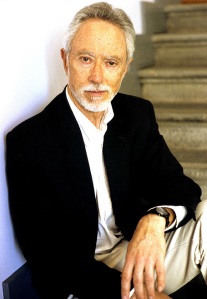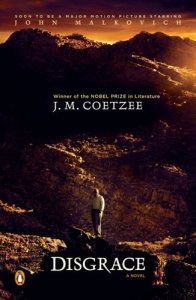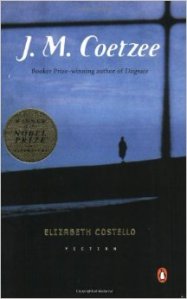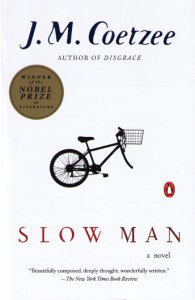Salim Al Tuwaiya
If the literary works of a writer are a portrait of his life, the works of the novelist J.M. Coetzee capture a living mirror image. From this life he derives the essence of his ideas and questions related to the universe, existence and humans. The purpose of this paper is not so much to investigate how much Coetzee and his characters matched, but to try to read his influences and the light they bring to his works.

http://www.telerama.fr/livre/j-m-coetzee-l-etincellant-pessimiste,59205.php
During concurrent periods Coetzee studied English and Mathematics at the University of Cape Town. In 1960 and 1961 he graduated with honours in both majors. After that he spent three years in Britain (1962- 1965) working as a computer programmer. Meanwhile, he completed research on the English novelist Ford Madox Ford. In 1968, at the age of twenty-eight, he received a PhD in English, Linguistics and Germanic languages at the graduate school at the University of Texas at Austin. His in-depth, ongoing academic and practical experience did not prevent him from pursuing writing.
J.M. Coetzee worked very hard to break into the world of literature. He was thirty-four years old when he published his first book in 1974. In 1977 he published his second novel In the Heart of the Country. Quickly he gained attention in his own country, South Africa, and also abroad. The novel was published in Britain and the U.S.A.
Coetzee was born in Cape Town, South Africa, on 9 February 1940. His father was a lawyer and his mother a primary school teacher. In 1963 he married Philippa Jubber and fathered her two sons, Nicholas in 1966 and Gisela in 1968. In 1980 Coetzee divorced his wife. She died in 1991, two years after Nicholas passed away in an accident at twenty-three.
Coetzee completed his primary, secondary and university education in Cape Town. He traveled to Britain and America to pursue his higher education and became a professor occupying several positions from the beginning of 1968 until now. He lives with his partner Dorothy Driver in the Australian city of Adelaide, which he migrated to in 2002. He holds an honorary position at its university. In 2006 he obtained Australian citizenship. He is a writer and an intellectual who is engaged with local and global issues. In 1972 he returned to South Africa after the United States refused to grant him permanent residence because of his involvement in the anti-Vietnam War activities, even though he was an assistant professor of English at New York University in Buffalo.
Coetzee has published 16 novels, including Dusklands (1974), In the Heart of the Country (1977), Life and Times of Michael K (1983), Age of Iron (1990), Disgrace (1999), Elizabeth Costello (2003), Slow Man (2005), The Childhood of Jesus (2013), and other works ranging between biography, literary criticism and essays.
In 1984, his novel Life and Times of Michael K won the British Booker Prize. Later in 1999 he won the Booker Prize again for his novel Disgrace, which received international acclaim. He was the first writer to win the Booker Prize twice. After a year of living in Australia, Coetzee won the Nobel Prize for Literature in 2003.
In recognition of the importance of his works, the Harry Ransom Centre at the University of Texas library bought Coetzee’s archive for $ US 1.5 million in 2011. The archive includes 155 boxes of articles and manuscripts, notes, letters and lectures by Coetzee since 1965. The archive also contains nine drafts of the novel The Life and Times of Michael K, which revolves around a simple gardener and his wife living in Cape Town when violent events break out.
What gives Coetzee’s novels momentum and suspense? He usually tends to address events in short sentences, unlike the long sentences full of details in the novels of Colombian writer Gabriel Garcia Marquez. Perhaps one of the most important features of Coetzee’s writing lies in short sentences that build a house, so to speak, brick by brick. He digs for deep meaning in a leisurely fashion. His style is very difficult to describe. Probably for this reason, some critics say that his novels lack excitement and thrills even though the opposite is true. The simple sentences disguise the fact that he is far from direct, and the reader has to work to find clarity.
Places, life experiences and ideas are an integral part of the writer’s career. Through one form or another the writer makes use of raw materials in the literary work he creates for his characters, and gives free rein to them to go toward their unexpected destinies. Coetzee’s life is eventful privately and publicly. Being a South African has shaped very rich material for his themes and ideas. He saw and lived the history of the apartheid closely. His novel Disgrace, for example, addresses and condemns this issue without falling into the trap of didacticism. He has mastered the narrative construction by economising his writing style, which supports the flow of events and paints characters spontaneously in complex human situations. In this novel, David Lurie, the professor of Modern Languages, loses his job at the university after seducing and molesting one of his students. He then leaves the city and goes to visit his daughter living in the countryside. While he is there, three Africans attack his daughter’s house, assault him, rape his daughter and set the house on fire. Contrary to what he expects, his daughter refuses to demand punishment of the aggressors, but rather she seeks to cut her relationship with her father and continues to live as if nothing has happened!
Coetzee wrote Disgrace in 1994, in the wake of the collapse of the apartheid rule in South Africa. There are those who interpret the daughter’s acceptance of what has happened to her as an acknowledgment of the change of the situation in South Africa. Is the daughter’s rape objectively equivalent to her father’s violating the sanctity of education and attempting to seduce his pupil? Again, Coetzee’s novels seem vague and need more than one reading. Time has changed and this novel confirms that the situation in South Africa is no longer as it used to be. Racism is indirectly condemned as events develop.
There are not many characters in Disgrace, which is not a bad thing. Too many characters could have intruded on the novel’s sense of isolation Perhaps this is another restriction imposed by the reclusive nature of Coetzee himself. Of course no one has the right to judge the writer’s life and assume his creative work corresponds to his experiences. However, one cannot ignore the fact that there are always some personal traits incorporated in one’s writing. Coetzee is well known for his love of isolation. To avoid any confusion it must be said that the deep roots of a genuine writer are creatively manifested in his writing as the result of relentless digging into the depths of the inner self. Literature, isolation, introversion and distance are a set of factors representing attributes that cannot be ignored in many of Coetzee’s novels such as Disgrace, Slow Man, and Elizabeth Costello.
In 1984 and 1999, the years when Coetzee won the British Booker Prize twice, he did not go to receive the two awards! He himself is as ambiguous as his novels’ characters. He is frequently described as an introvert, recluse, loner and unwilling to attend public events. These qualities do apply to most of his characters distinctively. Even at the level of literary events, Coetzee rarely mixes with communities of writers and does not seek to get closer to critics, but his works have ultimately stood on their own merits and become highly celebrated. He does not drink, smoke or eat meat and he maintains his fitness by bike riding every day in the city of Adelaide. One cannot overlook the fact that Paul Rayment, the solitary protagonist in Slow Man, lives in Adelaide, too.
The main event in this novel is a bicycle accident, which suddenly happens to Paul Rayment and leads to the amputation of his leg. In this story, Coetzee draws on his own experience as a cyclist to make the character of Paul Rayment more believable. The character of the cyclist is the essence and foundation of the novel. From that point on, Coetzee used his imagination to turn Paul Rayment into an independent character with his own distinctive traits. Paul Rayment left Coetzee and developed his own life.
The Czech writer Milan Kundera says: “The characters in my novel are my own unrealised possibilities… the novel is not the author’s confession; it is an investigation of human life in the trap the world has become.” Coetzee says: “Our lies reveal as much about us as our truths.” The relationship between the two quotes is strong, although it may be hard to realise that at first. In the history of world literature and poetry in particular, the element of lying is considered to involve a creative value. In this context Lying is associated with broad imagination deviating from rigid reality and the banality of daily life that does not necessarily represent objectivity, namely honesty or truth. The phrase is also open to another interpretation, in the sense that human souls tend to exaggerate and colour facts. So they wear masks to hide their reality, which results in the transformation and distortion of the human essence, which in turn leads to the ultimate existential puzzle: human’s constant search of truth through the creation of another reality. This philosophical and existential conflict is a prominent theme in the works of Coetzee.
 Therefore, the secrecy of the characters’ behaviours is a dominant psychological component in some of Coetzee’s novels. Uncertainty, confusion and introversion are defensive mechanisms sought by characters to live their lives. Thus, we find that Paul Rayment in Slow Man is anti-social and does not allow his friends to get closer to him, especially after suffering a traumatic experience that changes his life and forces him to review his past. He is in an untold misery: emptiness, wilt and indifference. In short, he slowly dies.
Therefore, the secrecy of the characters’ behaviours is a dominant psychological component in some of Coetzee’s novels. Uncertainty, confusion and introversion are defensive mechanisms sought by characters to live their lives. Thus, we find that Paul Rayment in Slow Man is anti-social and does not allow his friends to get closer to him, especially after suffering a traumatic experience that changes his life and forces him to review his past. He is in an untold misery: emptiness, wilt and indifference. In short, he slowly dies.
Tracking down Coetzee’s characters draws the reader’s attention to how they intersect with his own life experiences. Meanwhile, it certainly sheds light on the unique ability of the writer to separate his characters from himself and give them freewill and their own human qualities. Coetzee is able to inspect the innermost thoughts of an unhappy solitary human who suffers from the meaninglessness and absurdity of life.
Coetzee’s works present literature as an indispensable component of his life. Regarding Milan Kundera’s statement above, it is noted that although Coetzee is a university professor, he does not lecture! But he makes Elizabeth Costello, his novel’s eponymous heroine, travel around the world, lecturing and lecturing nonsense to the point of nausea.
Elizabeth Costello is almost devoid of events and focuses on the internal conflict going on in the depths of its characters: a male novelest and Costello, a critic. It is about the conflict of the thoughts and the endless confusion that arises from contradictions and lack of faith in anything. This novel is a good example of the intersection of the life of the writer and his characters, because one of its main heroes is a novelist, whom Elizabeth Costello attacks and strongly criticizes for writing about human evil, tyranny and oppression.
Sometimes it is hard to separate Coetzee’s characters from his reality. His life and literature are a bright testimony of the rejection of tyranny, injustice and repressive regimes. His novels reveal human bewilderment, weakness, evil and contradictions and have enabled him to take a prominent place in literature and become one of the greatest novelists in the world.
[…] The fascination with ideas as much as character links Coetzee and Kundera. Consider this idea […]
LikeLike
Fascinating themes and writing style mentioned inspire me to read Coetzee’s work.
LikeLike
Hi Kristine. Coetzee is one of the great novelists. I think you will enjoy reading any of his works. Thanks for passing by.
LikeLike
Hi Kristine, thanks for passing by. Indeed, the works of Coetzee are always renewed.
LikeLike
[…] https://whenwhenwhen.wordpress.com/2015/02/11/j-m-coetzees-life-and-its-influence-on-his-writing/ […]
LikeLike